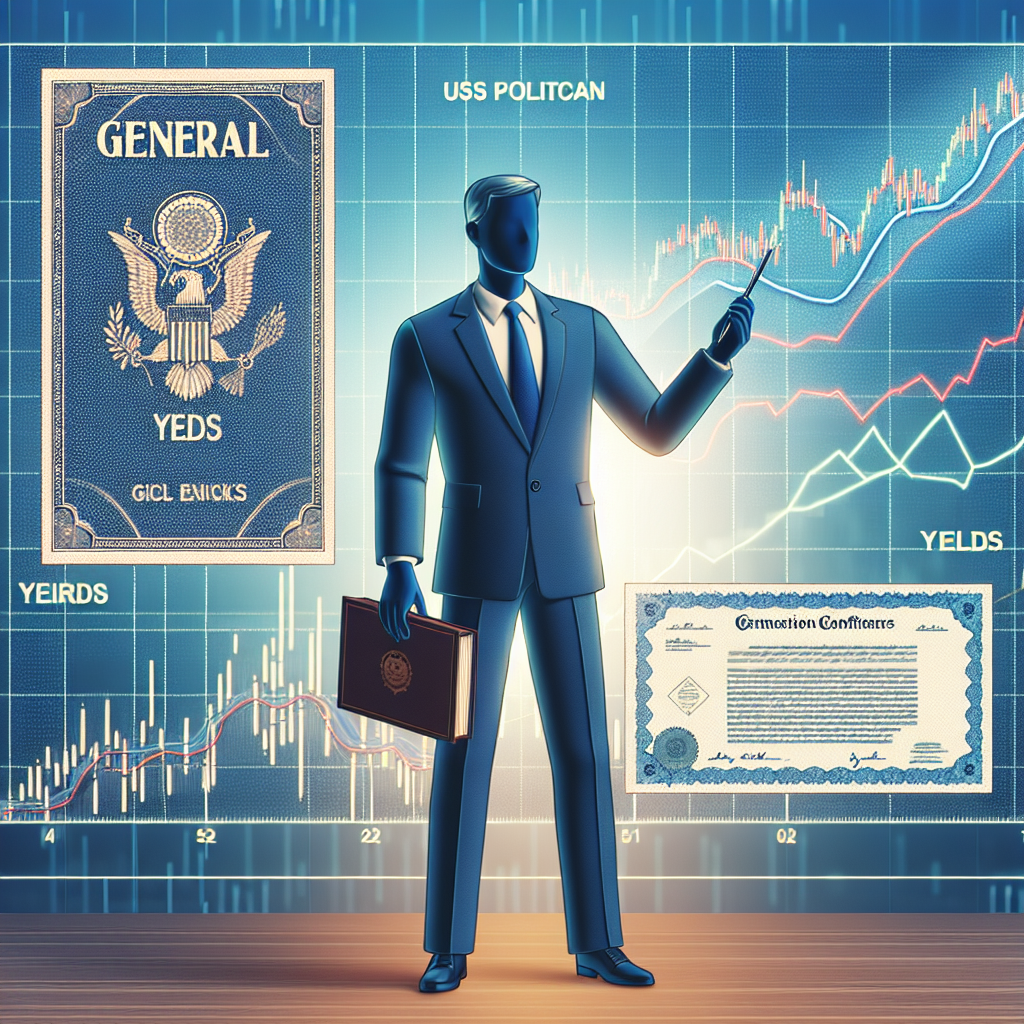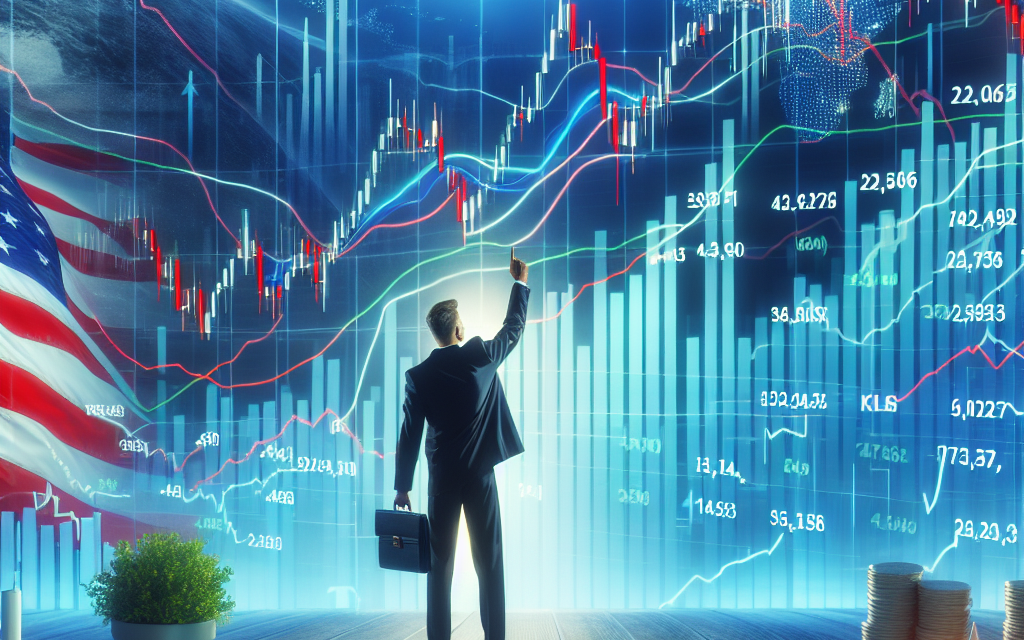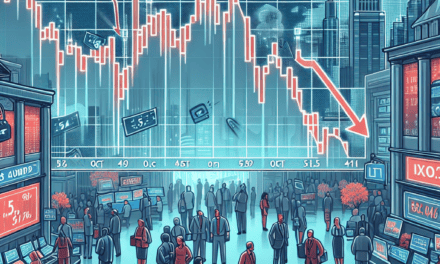“Trump Trades Surge: Navigating the Bullish Wave of US Stocks and Yields”
Introduction
In recent market developments, a notable surge in Trump-related trades has captured the attention of investors, coinciding with a broader upswing in U.S. stocks and bond yields. This trend reflects a complex interplay of political and economic factors influencing market dynamics. As the U.S. economy shows signs of resilience, with robust corporate earnings and economic indicators, investor sentiment has been buoyed, leading to increased trading activity linked to former President Donald Trump. The rise in bond yields further underscores expectations of sustained economic growth and potential shifts in monetary policy. This market overview delves into the factors driving these movements, examining the implications for investors navigating this evolving landscape.
Impact Of Trump Trades On US Stock Market Performance
The recent surge in Trump trades has captured the attention of investors and analysts alike, as these trades have become a significant factor in the broader performance of the US stock market. As the market experiences a period of rising stock prices and yields, understanding the impact of Trump trades is crucial for comprehending the current financial landscape. These trades, often characterized by investments in sectors and companies that were favored during Donald Trump’s presidency, have seen renewed interest as market participants anticipate potential policy shifts and economic developments.
To begin with, the resurgence of Trump trades can be attributed to several factors, including the anticipation of policy changes that could benefit certain industries. For instance, sectors such as energy, financials, and industrials, which thrived under the previous administration, are once again in the spotlight. Investors are speculating that potential regulatory rollbacks or infrastructure spending initiatives could provide a boost to these sectors, thereby driving up stock prices. This renewed interest is further fueled by the broader economic environment, where rising yields are prompting investors to seek out equities that offer growth potential and attractive returns.
Moreover, the impact of Trump trades on the US stock market is not limited to specific sectors. The overall market sentiment has been influenced by the perception that these trades could lead to a more robust economic recovery. As investors adjust their portfolios to capitalize on these opportunities, there is a noticeable shift in market dynamics. This shift is evident in the increased trading volumes and heightened volatility, as market participants react to news and developments related to potential policy changes. Consequently, the performance of Trump trades has become a barometer for gauging investor confidence and market expectations.
In addition to sector-specific impacts, Trump trades have also contributed to the broader trend of rising stock prices. As investors flock to these trades, the increased demand for stocks in favored sectors has led to upward pressure on prices. This, in turn, has contributed to the overall bullish sentiment in the market, as rising stock prices create a positive feedback loop that encourages further investment. Furthermore, the interplay between rising yields and stock prices has created a complex environment where investors must carefully balance risk and reward. As yields rise, the cost of borrowing increases, which can impact corporate profitability and, by extension, stock valuations. However, the potential for policy-driven growth in certain sectors provides a counterbalance to these concerns, making Trump trades an attractive option for many investors.
In conclusion, the surge in Trump trades amid rising US stocks and yields highlights the intricate relationship between policy expectations, market sentiment, and economic performance. As investors navigate this complex landscape, the impact of Trump trades on the US stock market performance cannot be understated. These trades not only influence sector-specific dynamics but also contribute to the broader trends shaping the market. As such, understanding the factors driving Trump trades and their implications for the stock market is essential for investors seeking to make informed decisions in an ever-evolving financial environment. As the market continues to evolve, the role of Trump trades will likely remain a focal point for investors and analysts alike, offering insights into the potential direction of the US economy and financial markets.
Analyzing The Surge In US Yields Amid Trump Trades
In recent months, the financial markets have witnessed a notable surge in Trump trades, coinciding with a rise in U.S. stocks and yields. This phenomenon has captured the attention of investors and analysts alike, prompting a closer examination of the underlying factors driving these market movements. As we delve into the intricacies of this trend, it is essential to consider the broader economic context and the interplay between various market forces.
To begin with, the term “Trump trades” refers to investment strategies that gained popularity following the election of Donald Trump as President of the United States in 2016. These trades typically involve sectors and assets expected to benefit from Trump’s policy agenda, such as infrastructure, defense, and financial services. The resurgence of Trump trades in recent times can be attributed to several factors, including renewed speculation about his potential influence on future economic policies and the broader political landscape.
Simultaneously, U.S. stocks have experienced a robust rally, driven by a combination of strong corporate earnings, resilient consumer spending, and optimism surrounding economic recovery. The stock market’s upward trajectory has been further bolstered by accommodative monetary policies and fiscal stimulus measures, which have provided a supportive backdrop for risk assets. As investors seek to capitalize on these favorable conditions, the alignment of Trump trades with rising stock prices has created a fertile ground for market participants to explore new opportunities.
In tandem with the surge in stocks, U.S. yields have also been on an upward trajectory. The increase in yields can be attributed to several interrelated factors, including expectations of higher inflation, improved economic growth prospects, and the Federal Reserve’s signaling of potential interest rate hikes. As yields rise, the cost of borrowing increases, which can have a ripple effect across various asset classes. This dynamic has prompted investors to reassess their portfolios, balancing the pursuit of higher returns with the need to manage interest rate risk.
The interplay between rising yields and Trump trades is particularly noteworthy, as it underscores the complex relationship between fiscal policy, monetary policy, and market sentiment. On one hand, higher yields can enhance the attractiveness of certain Trump trades, particularly those linked to sectors that stand to benefit from increased government spending and infrastructure investment. On the other hand, rising yields can also pose challenges for equities, as higher borrowing costs may weigh on corporate profitability and dampen investor enthusiasm.
Moreover, the global economic environment adds another layer of complexity to this market narrative. As the U.S. economy continues to recover from the disruptions caused by the COVID-19 pandemic, international factors such as geopolitical tensions, supply chain disruptions, and divergent monetary policies among major economies can influence investor sentiment and market dynamics. These external variables can either amplify or mitigate the impact of domestic developments, further shaping the trajectory of Trump trades and U.S. yields.
In conclusion, the surge in Trump trades amid rising U.S. stocks and yields reflects a confluence of factors that are reshaping the investment landscape. As market participants navigate this evolving environment, they must remain vigilant in assessing the implications of policy shifts, economic indicators, and global trends. By understanding the interconnectedness of these elements, investors can better position themselves to capitalize on opportunities while managing potential risks. As always, a nuanced and informed approach will be crucial in navigating the complexities of today’s financial markets.
Key Factors Driving The Rise In US Stocks And Yields
The recent surge in Trump trades has captured the attention of investors and analysts alike, as US stocks and yields experience a notable rise. This phenomenon can be attributed to a confluence of factors that are currently shaping the financial landscape. To understand the dynamics at play, it is essential to examine the underlying elements driving this upward trend in the market.
Firstly, the economic backdrop has been a significant contributor to the rise in US stocks and yields. The US economy has shown resilience in the face of global uncertainties, with robust consumer spending and a strong labor market underpinning growth. This economic strength has bolstered investor confidence, leading to increased demand for equities. Furthermore, corporate earnings have generally exceeded expectations, providing an additional boost to stock prices. As companies continue to report solid financial results, the positive sentiment surrounding equities is likely to persist.
In addition to economic fundamentals, monetary policy has played a crucial role in shaping market dynamics. The Federal Reserve’s stance on interest rates has been a focal point for investors. With the central bank signaling a more hawkish approach, expectations of future rate hikes have risen. This anticipation has led to an increase in bond yields, as investors adjust their portfolios in response to the changing interest rate environment. Higher yields, in turn, have made US Treasury securities more attractive, drawing capital into the bond market and contributing to the overall rise in yields.
Moreover, geopolitical factors have also influenced market movements. The ongoing trade negotiations and geopolitical tensions have created an environment of uncertainty, prompting investors to seek safe-haven assets. However, recent developments in trade talks have been perceived as positive, alleviating some of the concerns that have weighed on the market. As a result, risk appetite has improved, leading to a rotation from defensive assets into equities. This shift has further fueled the upward momentum in US stocks.
Another key factor driving the rise in stocks and yields is the performance of specific sectors. Technology and financial stocks, in particular, have been at the forefront of the market rally. The technology sector has benefited from strong demand for digital services and innovations, while financial stocks have gained from the prospect of higher interest rates, which can enhance profit margins for banks and financial institutions. The outperformance of these sectors has contributed significantly to the overall strength of the stock market.
Furthermore, investor sentiment has been buoyed by the prospect of fiscal stimulus measures. The potential for increased government spending on infrastructure and other initiatives has raised expectations for economic growth, providing an additional tailwind for equities. As policymakers continue to discuss and implement fiscal policies, the anticipation of further stimulus could sustain the positive momentum in the market.
In conclusion, the rise in US stocks and yields can be attributed to a combination of strong economic fundamentals, monetary policy shifts, geopolitical developments, sectoral performance, and fiscal stimulus expectations. These factors have collectively created an environment conducive to market growth, driving the surge in Trump trades. As investors navigate this complex landscape, the interplay of these elements will continue to shape market trends and influence investment decisions.
Investor Sentiment And Trump Trades: A Market Analysis

Investor sentiment has been a driving force in the financial markets, and recent trends have highlighted a notable surge in Trump trades amid rising U.S. stocks and yields. This phenomenon, characterized by investments that are perceived to benefit from policies associated with former President Donald Trump, has gained traction as market participants navigate the evolving economic landscape. The resurgence of Trump trades can be attributed to a confluence of factors, including the current economic environment, policy expectations, and investor psychology.
To begin with, the U.S. stock market has experienced a robust rally, buoyed by strong corporate earnings and a resilient economy. This upward momentum has been further supported by rising yields, which reflect investor confidence in economic growth. As yields increase, they often signal expectations of higher inflation and interest rates, prompting investors to reassess their portfolios. In this context, Trump trades have emerged as a focal point for those seeking to capitalize on sectors that thrived during his administration, such as energy, financials, and industrials.
Moreover, the anticipation of potential policy shifts has also played a crucial role in the resurgence of Trump trades. With the political landscape in constant flux, investors are keenly attuned to any developments that might influence fiscal and regulatory policies. The possibility of tax reforms, deregulation, and infrastructure spending reminiscent of the Trump era has reignited interest in sectors that stand to benefit from such measures. Consequently, market participants are positioning themselves to take advantage of these opportunities, driving demand for Trump-related assets.
In addition to economic and policy considerations, investor psychology has significantly influenced the market dynamics surrounding Trump trades. The concept of “animal spirits,” as coined by economist John Maynard Keynes, refers to the emotions and instincts that drive investor behavior. In this case, the nostalgia for the market-friendly policies of the Trump administration has rekindled enthusiasm among certain segments of the investor community. This sentiment is further amplified by the media’s portrayal of potential policy shifts, which can create a self-reinforcing cycle of optimism and investment activity.
Furthermore, the global economic backdrop has also contributed to the appeal of Trump trades. As geopolitical tensions and supply chain disruptions continue to pose challenges, investors are increasingly seeking assets that offer stability and growth potential. The sectors associated with Trump trades, such as energy and industrials, are perceived as resilient in the face of global uncertainties. This perception has bolstered their attractiveness, drawing capital from both domestic and international investors.
However, it is essential to recognize the inherent risks associated with Trump trades. While the current market environment may favor these investments, the landscape can shift rapidly due to unforeseen events or policy changes. Investors must remain vigilant and adaptable, continuously reassessing their strategies in response to evolving conditions. Diversification and risk management are crucial components of a prudent investment approach, ensuring that portfolios are well-positioned to weather potential volatility.
In conclusion, the surge in Trump trades amid rising U.S. stocks and yields underscores the complex interplay of economic, policy, and psychological factors shaping investor sentiment. As market participants navigate this dynamic environment, they must balance optimism with caution, recognizing both the opportunities and risks inherent in their investment decisions. By staying informed and adaptable, investors can effectively harness the potential of Trump trades while safeguarding their portfolios against potential headwinds.
The Role Of Economic Policies In Trump Trades Surge
The recent surge in Trump trades, characterized by increased investments in sectors that were favored during Donald Trump’s presidency, has captured the attention of market analysts and investors alike. This phenomenon is occurring amid a broader rise in U.S. stocks and yields, prompting a closer examination of the economic policies that may be contributing to this trend. Understanding the role of these policies is crucial for comprehending the dynamics at play in the current market environment.
To begin with, it is essential to recognize that Trump trades typically involve sectors such as energy, financials, and industrials, which were perceived to benefit from the former administration’s policies. These sectors are now experiencing renewed interest as investors anticipate potential policy shifts that could favor their growth. The resurgence of these trades can be attributed, in part, to the expectation of regulatory rollbacks and tax reforms that were hallmarks of Trump’s economic agenda. Such policies are believed to create a more business-friendly environment, thereby boosting investor confidence and driving capital into these sectors.
Moreover, the rise in U.S. stocks and yields has been influenced by a combination of factors, including robust economic data and expectations of continued fiscal stimulus. The interplay between these elements and the legacy of Trump’s economic policies cannot be overlooked. For instance, the tax cuts implemented during his tenure have had a lasting impact on corporate earnings, which in turn supports higher stock valuations. Additionally, the emphasis on deregulation has provided a conducive environment for businesses to thrive, further enhancing the attractiveness of Trump trades.
In addition to these domestic factors, global economic conditions also play a significant role in shaping market trends. The ongoing recovery from the COVID-19 pandemic has led to increased demand for commodities and industrial goods, sectors that align with Trump trades. As economies worldwide continue to rebound, the demand for energy and raw materials is expected to rise, benefiting companies within these industries. This global context, combined with favorable domestic policies, creates a compelling case for the resurgence of Trump trades.
Furthermore, the current monetary policy landscape, characterized by rising yields, adds another layer of complexity to the market dynamics. Higher yields often signal expectations of economic growth and inflation, which can lead to a rotation of investments into sectors that are poised to benefit from such conditions. Trump trades, with their focus on cyclical industries, are well-positioned to capitalize on this shift. Investors seeking to hedge against inflation and capitalize on growth prospects may find these sectors particularly appealing.
In conclusion, the surge in Trump trades amid rising U.S. stocks and yields can be attributed to a confluence of factors, including the enduring impact of economic policies from the Trump era, robust domestic and global economic conditions, and the current monetary policy environment. As investors navigate this complex landscape, understanding the role of these policies is essential for making informed decisions. The interplay between policy expectations, market trends, and economic indicators will continue to shape the trajectory of Trump trades, offering both opportunities and challenges for market participants. As such, staying attuned to these developments will be crucial for those looking to capitalize on the evolving market dynamics.
Comparing Trump Trades With Historical Market Trends
In recent months, the financial markets have witnessed a notable surge in what are colloquially referred to as “Trump trades,” a term that gained prominence during Donald Trump’s presidency. These trades typically involve investments in sectors such as infrastructure, defense, and financial services, which were expected to benefit from Trump’s policy initiatives. As US stocks and yields rise, it is essential to compare these trades with historical market trends to understand their implications and potential longevity.
To begin with, the resurgence of Trump trades can be attributed to several factors, including the anticipation of policy shifts and economic strategies reminiscent of the Trump era. Investors are keenly observing the political landscape, speculating on potential regulatory changes and fiscal policies that could favor certain industries. This speculative behavior is not unprecedented; historically, markets have often reacted to political developments, with investors adjusting their portfolios in anticipation of policy-driven economic shifts.
Looking back, the initial wave of Trump trades emerged in late 2016, following Trump’s election victory. At that time, markets responded to promises of tax cuts, deregulation, and infrastructure spending, leading to a rally in stocks associated with these sectors. The financial sector, in particular, experienced significant gains, driven by expectations of deregulation and rising interest rates. Similarly, defense stocks surged on the back of anticipated increases in military spending. This pattern of market behavior underscores a broader historical trend where political events and policy announcements significantly influence investor sentiment and market dynamics.
However, it is crucial to recognize that while political developments can catalyze market movements, they are not the sole determinants of long-term trends. Economic fundamentals, such as corporate earnings, interest rates, and global economic conditions, play a pivotal role in shaping market trajectories. For instance, the current rise in US stocks and yields is not solely a result of political speculation but also reflects broader economic recovery and growth prospects. As the economy rebounds from the disruptions caused by the COVID-19 pandemic, corporate earnings have shown resilience, bolstering investor confidence and driving stock prices higher.
Moreover, the increase in yields is indicative of expectations for future economic growth and potential inflationary pressures. Historically, rising yields have been associated with periods of economic expansion, as investors demand higher returns in anticipation of inflation and stronger economic activity. This relationship between yields and economic growth further highlights the complexity of market dynamics, where multiple factors interplay to influence investor behavior and asset prices.
In comparing Trump trades with historical market trends, it becomes evident that while political developments can trigger short-term market reactions, sustainable trends are often underpinned by economic fundamentals. Investors must therefore exercise caution and consider a holistic view of the market landscape, balancing political speculation with an understanding of underlying economic conditions. As the financial markets continue to evolve, the interplay between politics and economics will remain a critical factor in shaping investment strategies and market outcomes.
In conclusion, the recent surge in Trump trades amid rising US stocks and yields reflects a confluence of political speculation and economic fundamentals. By examining historical market trends, investors can gain valuable insights into the potential implications and sustainability of these trades. As always, a comprehensive approach that considers both political and economic factors will be essential for navigating the complexities of the financial markets.
Future Outlook: Sustaining The Momentum In US Stocks And Yields
As the financial markets continue to evolve, the recent surge in Trump trades has captured the attention of investors and analysts alike. This phenomenon, characterized by increased trading activity in assets associated with former President Donald Trump, has coincided with a broader rise in U.S. stocks and yields. To understand the future outlook and the sustainability of this momentum, it is essential to examine the underlying factors driving these trends and consider the potential implications for the market.
Firstly, the resurgence of Trump trades can be attributed to a combination of political developments and investor sentiment. With the former president maintaining a significant presence in the political arena, his influence on certain sectors, such as energy and infrastructure, remains substantial. Consequently, investors are keenly observing policy shifts and potential regulatory changes that could impact these industries. This heightened attention has led to increased trading volumes and volatility in related stocks, as market participants seek to capitalize on perceived opportunities.
Simultaneously, the broader rise in U.S. stocks can be linked to a robust economic recovery, fueled by strong corporate earnings and consumer spending. As businesses continue to rebound from the pandemic-induced downturn, many have reported better-than-expected financial results, bolstering investor confidence. Additionally, the labor market has shown signs of improvement, with unemployment rates gradually declining. These positive economic indicators have contributed to a bullish sentiment, encouraging further investment in equities.
Moreover, the increase in U.S. yields has played a crucial role in shaping market dynamics. As inflationary pressures mount, the Federal Reserve has signaled its intention to adjust monetary policy accordingly. This has led to a rise in bond yields, reflecting expectations of tighter monetary conditions in the future. Higher yields have, in turn, influenced investor behavior, prompting a reevaluation of asset allocations. While some investors have shifted towards fixed-income securities to capitalize on rising yields, others have remained focused on equities, anticipating continued growth in corporate profits.
In light of these developments, the future outlook for U.S. stocks and yields hinges on several key factors. One critical consideration is the trajectory of inflation and the Federal Reserve’s response. Should inflationary pressures persist, the central bank may be compelled to implement more aggressive rate hikes, which could dampen economic growth and weigh on stock valuations. Conversely, if inflation proves to be transitory, the Fed may adopt a more gradual approach, allowing equities to maintain their upward momentum.
Furthermore, geopolitical events and domestic policy decisions will likely influence market sentiment. As the U.S. navigates complex international relationships and addresses pressing issues such as infrastructure spending and tax reform, investors will closely monitor developments for potential impacts on various sectors. The interplay between these factors will ultimately determine the sustainability of the current market trends.
In conclusion, the recent surge in Trump trades amid rising U.S. stocks and yields reflects a confluence of political, economic, and monetary influences. While the future outlook remains uncertain, understanding the drivers behind these trends provides valuable insights for investors seeking to navigate the evolving landscape. By staying attuned to economic indicators, policy shifts, and geopolitical developments, market participants can better position themselves to capitalize on opportunities and mitigate risks in this dynamic environment.
Q&A
1. **What is the Trump Trades Surge?**
– The Trump Trades Surge refers to the market movements and investment strategies that gained popularity following Donald Trump’s election, characterized by increased stock market activity and expectations of economic growth driven by his policies.
2. **How are US stocks performing amid the Trump Trades Surge?**
– US stocks have been rising, reflecting investor optimism about economic growth, tax cuts, and deregulation policies anticipated under Trump’s administration.
3. **What sectors are benefiting the most from the Trump Trades Surge?**
– Financials, industrials, and energy sectors have been among the biggest beneficiaries, as investors expect these sectors to gain from deregulation, infrastructure spending, and favorable tax policies.
4. **How are bond yields reacting to the Trump Trades Surge?**
– Bond yields have been rising, driven by expectations of increased government borrowing, higher inflation, and potential interest rate hikes as the economy strengthens.
5. **What impact does the Trump Trades Surge have on the US dollar?**
– The US dollar has generally strengthened, as higher yields and expectations of economic growth attract foreign investment.
6. **Are there any risks associated with the Trump Trades Surge?**
– Risks include potential policy implementation challenges, geopolitical uncertainties, and the possibility of overheating the economy, which could lead to inflationary pressures.
7. **How are global markets responding to the Trump Trades Surge?**
– Global markets have shown mixed responses, with some benefiting from increased US demand and others facing challenges due to a stronger dollar and potential trade policy shifts.
Conclusion
The recent surge in Trump-related trades amid rising U.S. stocks and yields highlights a renewed investor interest in sectors and companies associated with the former president’s policies and business ventures. This trend reflects broader market dynamics where investors are seeking opportunities in areas perceived to benefit from potential regulatory changes, fiscal policies, or economic conditions reminiscent of the Trump administration. The increase in stock market performance and yields suggests a robust economic outlook, encouraging risk-taking and speculative investments. However, this trend also underscores the volatility and unpredictability inherent in markets influenced by political figures and their associated economic narratives. As such, while the current surge presents lucrative opportunities, it also necessitates cautious optimism and strategic risk management from investors.




